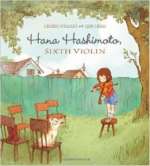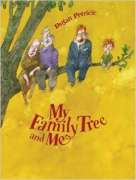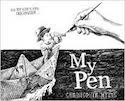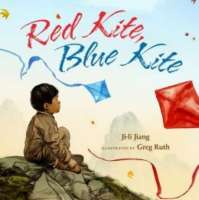What/Who Empowers Young Children in Their Lives?
By Yoo Kyung Sung & Michelle Ebersole
July 2015

Michelle:
Yoo Kyung, Hana Hashimoto, Sixth Violin was a delightful read this week. I thought the book represented this month’s theme, “What/who empowers young children in their lives?” In the story, the main character Hana announces that she entered the school talent show after having only three violin lessons and her brothers tell her that she will be a disaster. Given their discouraging words, it seems like it would have been easy for Hana to give up; however, the story explains how Hana is inspired by her grandfather during her recent visit to Japan where she listened to her Ojiichan (grandfather) play the violin. He had been part of a “great symphony orchestra in Kyoto.” She practices diligently, not only for her lessons but also for her talent show and is unwavering in her determination, despite her brothers’ continued laughter and discouraging remarks. Preceding the performance she wavers for a moment; but courageously proceeds. Seeing her supporters and imagining her grandfather in the crowd she is encouraged to “do her best.”
It seemed to me that Hana had confidence and sense of empowerment within herself but she also found joy, motivation, and courage through her Ojiichan whose music inspired her. Her parents were supportive as well, listening with care, while she practiced and stood by her smiling and with camera in hand while she performed. Her best friend, Jas, is also portrayed as an encouraging friend who attends the performance giving her “two thumbs up” right before she starts. So despite her brothers’ disheartening words, along with the encouragement of others Hana is able to find her own courage to stand tall and play the violin. While her music may not be the conventional or sophisticated the way her grandfather plays, I like how Hana creates her own voice and plays music which suits who she is and what she has learned at that point in time. It is done in a tasteful way, depicting real sounds of the world. I think that it is very encouraging for young children, who may be discouraged by others who may tease based on societies or our own expectations of success. I feel story encourages young children, like Hana to find one’s own sense of self and success can be what might be “just right” for them.
What are your thoughts?
Yoo Kyung:
Michelle, children are amazing. They believe in themselves and are powerfully resilient. Despite being laughed at and doubted by her siblings, Hana persisted, knowing it would take a lot of practice. Practice would lead to accomplishment, proving her musical ability. As you said, our theme on “things that empower children” are well served in Hana’s story — personal interest, spiritual and practical family support, self-confirmation, and resiliency. Also, I am delighted to have found a new contemporary realistic fiction about Japanese culture. I haven’t seen a wide range of Japanese realistic fiction, especially in a picture book format that depicts contemporary childhood in Japan. Instead, there has been a lot of historical fiction available for the U.S. audience about Japan in WWII. Somebody noted that characters in this book have brown hair so that “they do not look like Japanese people.” These illustrations reflect a particular style that shows a popular Japanese aesthetic trend in picture books that mirrors animation films. Illustrating Japanese characters like Western white characters in books is not new in Japanese pictorial texts such as Manga, Animation, picture books etc. It is so critical to have another contemporary Japanese realistic fiction book that has a powerful girl protagonist who reflects both contemporary and universal themes.
 My Family Tree and Me
My Family Tree and Me
Michele:
I enjoyed reading both pictures and text for this children’s book. Since it is presented as a photo album, the pictures alone tell a story. The straightforward and patterned accompanying text provides additional information which supports the illustrations rather than the illustrations supporting the text. I believe it is a book that children may return to for separate readings, studying the pictures and making different observations and connections each time. I was drawn to the caricature like illustrations which emphasized family resemblances within a racially and ethnically diverse family. Children today can identify with the family structures and cultures presented in the story which represent families that exist in today’s society.
The photo album is creatively designed with the character’s “father’s side” which begins at one end of the book and his “mother’s side” beginning at the other end of the book. On the end page the author/illustrator cleverly includes an invitation to the reader, explaining how the reader might explore the story. Additionally, the backdrop for the end pages are filled with drawings of diverse facial features, emphasizing different shapes, sizes, expressions individuals have. These clues invite the reader to note the unique, yet similar physical features in the family.
There are messages about diversity in terms of how one family may have differences in terms of gender, age, preference, and/or race. Through rich pencil drawings and vibrant watercolors, the illustrator depicts the richness of diversity in one family over the generations. Young children can see how some physical traits may be similar or different from one’s parents. Differences can be noted by children, yet everyone comes together and meets in the middle of the story as one big happy family.
Yoo Kyung:
This book may look like a book about an ordinary family tree, but it is more than that. It is important because of its multicultural context which recognizes diversity within an ordinary family tree. When we think of a family tree, a simplified ethnicity in family history is assumed, yet this book portrays a wide range of cultural diversity in the family’s reflection on its heritage. As you said, differences are everywhere and differences are a crucial element in connections people make. We live in a digitally convenient time where, perhaps, we do not need a physically thick photo album in order to share family stories and histories. The book offers universal connections among people through a theme of a family tree imbued with rich stories, memories, and more. My Family Tree and Me will provide great model for young children for creating their own family tree while searching for those expected and unexpected stories. Because of the fun and engaging illustration styles, children will be inspired to draw more stories of their own too.
Michele:

I found this week’s book, My Pen, by Christopher Myers quite different from our typical book choices. Many times the stories we select have an ethnic or cultural thread; however, with this book it is the possibility and power of children’s imagination and creativity that illustrates this week’s theme, “What empowers young children in their lives?”
The child starts out saying that there are rich and famous people that sometimes make him feel small; but he shows the reader how – through this inanimate object, his pen, that one can find the exponential power to express him/herself. His pen takes him on imaginative rides: it can tap dance on the sky, or go on adventures to exotic and foreign lands; it can do magic: hide an elephant in a teacup or ride dinosaurs; it is smart; it worries; it even makes mistakes. As a reader, I was intrigued by the authors words and captivated by the expressive pen and ink drawings. By the end of the book, I was inspired by the power of the pen that, “can do anything, anywhere.” I think that this was an excellent book choice for the theme this week. The rich illustrations along with the imaginative thoughts and musings of a child attract young readers to use their pens “see what you can do – “
Yoo Kyung:
I also want to focus on the beginning where the boy says “sometimes I feel small when I see those rich and famous people.” It makes me wonder if adult readers would find this just as relevant and appealing as children do. The boy describes the pen as a magical tool which empowers him. He realizes that he does not envy the rich and famous when he has his pen. I feel, though, that this particular comparison of a pen to the rich and famous, is a bit awkward. The boy imagines different worlds, beautiful things, and fun ideas through out the book. This child-like voice is common in otherchildren’s picture books, like Something Beautiful by Sharon Dennis Wyeth (2002). The boy also shows a mature perspective when addresses reality as he looks at current events, like wars, in the world through his pen. His pen is a symbolically powerful tool that is both playful while allowing access to other worlds through his imaginative tool. As you said, it is an excellent book on the theme of “ what empowers young children in their lives.” Also, I appreciate that the artist’s, and hence the protagonist’s, background is of African-American ethnicity, but these drawing of imagination involved stories reflect mainstream settings or animal characters. This book may attract more adult-audiences than young children with its “feeling good” messages, which can be attractive for adults. I may be stretching a bit but, My Pen echoes over the arching themes and powerful images of the Olympics: love, peace, and harmony. I question, to some degree, how authentic this book is in portraying childhood. I would welcome some young children’s thoughts about My Pen.

Michele’s Take: This week’s story, Red Kite, Blue Kite by Ji-li Jiang and illustrated by Greg Ruth tells an important story of China’s Cultural Revolution. Although it was a chaotic and tumultuous time, the story is thoughtfully told through the eyes of a young child and unconditional love and hope prevail.
This book is a perfect way for us to conclude this month’s discussion around the question, “What empowers young children in their lives?” It seems like with each reading there was a significant character, such as Ojiichan in Hana Hashimoto or a meaningful object, like the pen in My Pen, which motivate children to empower themselves. In this story, Tai Shan’s father, Baba, is the significant person in the main character’s life and the kites served as an eloquent symbol of hope and freedom. With the grave nature of the historical events in the story, there was a serious tone throughout the story; however, the story highlights the kites, thus, there is always a ray of light and hope in the horizon. In the beginning of the story, Tai Shan and his father, find joy and pleasure flying kites. They are captivated by the kites’ unpredictable movements and how they dance in the wind. In this story however, the kites become so much more than a child’s toy. When Tai Shan’s father is taken away, he maintains hope that his father will return to him. The kites become Tai Shan and his father’s lifeline for communication and through the kites, they are able to show each other their love and devotion. By the end of the story when his father returns, the kites are alive and free as they, “hop and giggle, and cheer and they rise and dive, soaring and lunging together. They are free flying everywhere.”
What made this story an even more powerful read, is the author’s note at the end. It explains that the story was based on the experience of a family friend. For me, I was surprised and inspired to learn that the kites were a true source of hope and faith that supported a young child through difficult times.
Yoo Kyung’s Take: Kites have been a popular topic in children’s stories, especially stories about Asia and the Middle East. Sometimes I think that the kite is an over-represented cultural icon for Asia. It has been one of the “Asian spices” found in children’s books, like dragons, even though there are differences in kite styles found in different Asian regions. When I see a kite in stories set in an Asian country, I cannot help but be skeptical of the accuracy of the portrayals. However, Red Kite Blue Kite is not the case. I realize that there is a difference between “then” and “now” in that kites used to be more visible in children’s lives. I remember making and flying a kite as a key part of our art curriculum in school when I was a child. Today, flying a kite is no longer a common pastime for the majority of children because they have so many other options with which to play. Red Kite, Blue Kite, portrays the way in which kites were an outlet for people during the cultural revolution. The kite provides resiliency to young Tai Shan, whose single father is taken away. When you really think about it, a kite requires a lot of effort to make and fly. Make it incorrectly and it won’t fly. Its construction demands meticulous attention to detail, otherwise it will fail to fly for lack of aerodynamic balance. Although this book doesn’t specifically mention that Tai Shan and his father made the kite together, I suspect that they did so instead of buying one at the “Toys-R-Us” of that era. Like reading, the kite became a father and son bonding experience. The kite, as an affordable toy, symbolizes a strong faith in oneself and well-wishes for others. I appreciate that this book does not focus solely on hardship during the Chinese Cultural Revolution, but depicts the hope and honest interest of children from their perspective. As you pointed out, the language in this book is poetic, which makes the book even more engaging. It says, “when I open my eyes, dozens of kites-red and blue- are waving and giggling at me.” Such playful language provides a pleasant feel to the story, one that is historical and yet provides a powerful relevancy in children’s lives — special objects sometimes are rays of hope in their lives.

Ray and Prisca, Thanks again for reminding us of the power of visual text and the profound affect just one color has on the meaning. I had a conversation a few minutes ago with a colleague who asked me, “At what age do kids begin to read?” When I talked about the visual text and the meaning gained from it, he was surprised. I’m going to share your My Takes with him–I suspect he will never look at picture books the same!
I am a retired teacher who consults with parents of gifted children. A partner and I co-facilitate SENG Model Parent Groups. Fine literature is always a topic! These will be on our list!